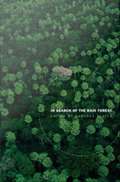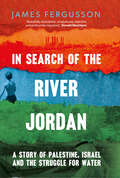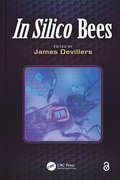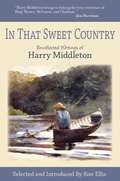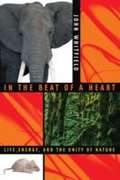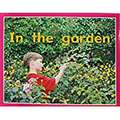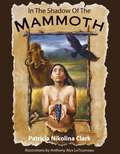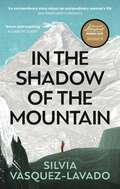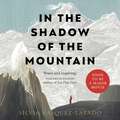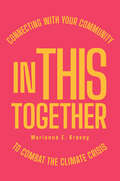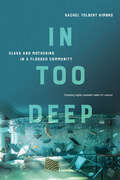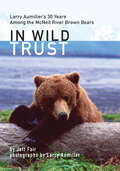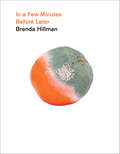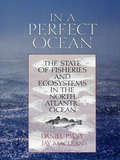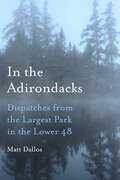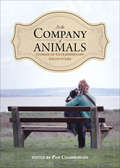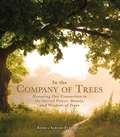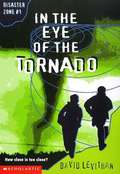- Table View
- List View
In Search of the Rain Forest
by Candace SlaterThe essays collected here offer important new reflections on the multiple images of and rhetoric surrounding the rain forest. The slogan "Save the Rain Forest!"--emblazoned on glossy posters of tall trees wreathed in vines and studded with monkeys and parrots--promotes the popular image of a marvelously wild and vulnerable rain forest. Although representations like these have fueled laudable rescue efforts, in many ways they have done more harm than good, as these essays show. Such icons tend to conceal both the biological variety of rain forests and the diversity of their human inhabitants. They also frequently obscure the specific local and global interactions that are as much a part of today's rain forests as are the array of plants and animals. In attending to these complexities, this volume focuses on specific portrayals of rain forests and the consequences of these characterizations for both forest inhabitants and outsiders. From diverse disciplines--history, archaeology, sociology, literature, law, and cultural anthropology--the contributors provide case studies from Latin America, Asia, and Africa. They point the way toward a search for a rain forest that is both a natural entity and a social history, an inhabited place and a shifting set of ideas. The essayists demonstrate how the single image of a wild and yet fragile forest became fixed in the popular mind in the late twentieth century, thereby influencing the policies of corporations, environmental groups, and governments. Such simplistic conceptions, In Search of the Rain Forest shows, might lead companies to tout their "green" technologies even as they try to downplay the dissenting voices of native populations. Or they might cause a government to create a tiger reserve that displaces peaceful peasants while opening the doors to poachers and bandits. By encouraging a nuanced understanding of distinctive, constantly evolving forests with different social and natural histories, this volume provides an important impetus for protection efforts that take into account the rain forest in all of its complexity. Contributors. Scott Fedick, Alex Greene, Paul Greenough, Nancy Peluso, Suzana Sawyer, Candace Slater, Charles Zerner
In Search of the River Jordan: A Story of Palestine, Israel and the Struggle for Water
by James FergussonA writer&’s travels along the legendary yet contested Jordan River—exploring the long conflict over water supply Access to water has played a pivotal role in the Israel-Palestine dispute. Israel has diverted the River Jordan via pipes and canals to build a successful modern state. But this has been at the expense of the region&’s cohabitants. Gaza is now so water-stressed that the United Nations has warned it could soon become uninhabitable; its traditional water source has been ruined by years of over-extraction and mismanagement, the effects exacerbated by years of crippling blockade. Award-winning author and journalist James Fergusson travels to every corner of Israel and Palestine telling the story of the River Jordan and the fierce competition for water. Along the way, he meets farmers, officials, soldiers, refugees, settlers, rioting youth, religious zealots, water experts, and engineers on both sides of the Green Line. Fergusson gives voice to the fears and aspirations of the region&’s inhabitants and highlights the centrality of water in negotiating future peace.
In Silico Bees
by James DevillersBees are critically important for ecosystem function and biodiversity maintenance through their pollinating activity. This book provides a collection of computational methods to those primarily interested in the study of the ecology, ethology, and ecotoxicology of bees. It presents numerous case studies to enable readers to understand the appropriateness but also the limitations of models in theoretical and applied bee research. Written by an international team of experts, this book covers the main types of modeling approaches that can be used in terrestrial ecology and applied ecotoxicology.
In That Sweet Country: Uncollected Writings of Harry Middleton
by Ron Ellis Harry MiddletonA moving collection of fishing stories by one of America’s legendary outdoor writers.Throughout his career, Harry Middleton contributed hundreds of stories, essays, and book reviews to some of the most respected periodicals, including the New York Times, Sports Illustrated, Gray’s Sporting Journal, and Field & Stream, among others. When he died in 1993, Middleton left behind a legacy rich with mountain streams, wild trout, and fishermen’s dreams.In That Sweet Country is a fresh, exhilarating collection of a renowned fishing writer’s previously published works. A recognized name in outdoor writing, Middleton brings us inspiring selections such as "An Angler’s Lament” from Southern Living (1987), "Spring on the Miramichi” from The Flyfisher (1991), "A Haunting Obsession with Brown Trout” from the New York Times (1992), and many more. Readers who love Middleton’s work will cherish this compilation, while novice fishermen will gain a view of the world as Middleton saw it: "There are so few left, so few who believe the earth is enough.”Skyhorse Publishing is proud to publish a broad range of books for fishermen. Our books for anglers include titles that focus on fly fishing, bait fishing, fly-casting, spin casting, deep sea fishing, and surf fishing. Our books offer both practical advice on tackle, techniques, knots, and more, as well as lyrical prose on fishing for bass, trout, salmon, crappie, baitfish, catfish, and more. While not every title we publish becomes a New York Times bestseller or a national bestseller, we are committed to publishing books on subjects that are sometimes overlooked by other publishers and to authors whose work might not otherwise find a home.
In The Beat Of A Heart: Life, Energy, And The Unity Of Nature
by John WhitfieldFor centuries, scientists have dreamt of discovering an underlying unity to nature. Science now offers powerful explanations for both the dazzling diversity and striking similarities seen in the living world. Life is complicated. It is truly the “entangled bank” that Charles Darwin described. But scientists are now discovering that energy is the unifying force that joins all life on Earth. Visionary biologists have advanced a new theory that explains how the natural world—from the tiniest amoeba to the greatest rain forest—is constructed, providing a fresh perspective on the essential interconnectivity of living systems. This revolutionary theory explains a variety of phenomena—helping us understand why a shrew eats its bodyweight in food each day, why a mammal’s heart beats about 1 billion times in its lifetime, why there are no trees as tall as the Eiffel Tower, and why more species live at the Earth’s equator than at its poles. By looking at how living things use energy, we can answer these and myriad other intriguing questions. In the Beat of a Heart combines biography, history, science and nature writing to capture the exciting advances— and the people who are making them—that are triggering a revolution as potentially important to biology as Newton’s insights were to physics.
In The Garden (Rigby PM Plus Starters #Magenta (Level 1))
by RigbyA learn-to-read story about insects, spiders and other garden creatures.
In The Shadow Of The Mammoth
by Patricia Nikolina Clark Anthony Alex LetourneauAt eleven summers, Zol approaches manhood in his clan of Ice Age Hunters. He should be eager for his first mammoth hunt, but shameful fear gnaws at his insides like a hungry rat. Fear of disgracing his brave father’s memory drives Zol to prove himself worthy of the Star Dancer clan. In his quest for courage, Zol barely escapes death in a raging river, stands face-to-face with a young mammoth, and survives two attacks by a long-toothed cat. Zol gains confidence from these encounters. But will his new-found courage stand the test of the mammoth hunt?
In The Shadow of the Mountain
by Silvia Vasquez-Lavado*****'Silvia Vasquez-Lavado is a warrior. I'm in awe of her strength and courage.' - Selena Gomez'powerful' - New York TimesIn the Shadow of the Mountain has all the elements a great memoir requires - a strong voice, cinematic prose, a hero to root for - in essence, an extraordinary story about an extraordinary woman's life.' - San Francisco Chronicle'Silvia Vasquez-Lavado is a woman possessed of uncommon strength, rare compassion, and a ferocious stubbornness to not allow the trauma of her childhood to destroy her life.' - Elizabeth Gilbert, author of Eat, Pray, Love YOU DON'T CONQUER A MOUNTAIN. YOU SURRENDER TO IT ONE STEP AT A TIME. Despite a high-flying career, Silvia Vasquez-Lavado knew she was hanging by a thread. Deep in the throes of alcoholism, and hiding her sexuality from her family, she was repressing the abuse she'd suffered as a child.When her mother called her home to Peru, she knew something finally had to change. It did. Silvia began to climb. Something about the sheer size of the mountains, the vast emptiness and the nearness of death, woke her up. And then, she took her biggest pain to the biggest mountain: Everest. The 'Mother of the World' allows few to reach her summit, but Silvia didn't go alone. Trekking with her to Base Camp, were five troubled young women on an odyssey that helped each confront their personal trauma, and whose strength and community propelled Silvia forward...Beautifully written and deeply moving, In the Shadow of the Mountain is a remarkable story of compassion, humility, and strength, inspiring us all to find have faith in our own heroism and resilience.
In The Shadow of the Mountain
by Silvia Vasquez-Lavado*****"Silvia Vasquez-Lavado is a woman possessed of uncommon strength, rare compassion, and a ferocious stubbornness to not allow the trauma of her childhood to destroy her life." - Elizabeth Gilbert, author of Eat, Pray, Love"Told with searing honesty, this vividly wrought memoir chronicles an almost superhuman journey from the deep vortex of trauma and self-destructive compulsions to the heights of physical endurance and spiritual emergence."- Dr. Gabor Maté, Bestselling Author of In The Realm Of Hungry Ghosts"Silvia Vasquez-Lavado is a warrior. I'm in awe of her strength and courage." - Selena Gomez YOU DON'T CONQUER A MOUNTAIN. YOU SURRENDER TO IT ONE STEP AT A TIME. Despite a high-flying career, Silvia Vasquez-Lavado knew she was hanging by a thread. Deep in the throes of alcoholism, and hiding her sexuality from her family, she was repressing the abuse she'd suffered as a child.When her mother called her home to Peru, she knew something finally had to change. It did. Silvia began to climb.Something about the sheer size of the mountains, the vast emptiness and the nearness of death, woke her up. And then, she took her biggest pain to the biggest mountain: Everest. The 'Mother of the World' allows few to reach her summit, but Silvia didn't go alone. Trekking with her to Base Camp, were five troubled young women on an odyssey that helped each confront their personal trauma, and whose strength and community propelled Silvia forward...Beautifully written and deeply moving, In the Shadow of the Mountain is a remarkable story of compassion, humility, and strength, inspiring us all to find have faith in our own heroism and resilience.(p) Octopus Publishing Group 2022
In This Together: Connecting with Your Community to Combat the Climate Crisis
by Marianne E. KrasnyIn This Together explores how we can harness our social networks to make a real impact fighting the climate crisis. Against notions of the lone environmental crusader, Marianne E. Krasny shows us the power of "network climate action"—the idea that our own ordinary acts can influence and inspire those close to us. Through this spread of climate-conscious practices, our individual actions become collective ones that can eventually effect widespread change.Weaving examples of everyday climate-forward initiatives in with insights on behavioral and structural change, Krasny demonstrates how we can scale up the impact of our efforts through leveraging our community connections. Whether by inviting family, friends, or colleagues to a plant-rich meal or by becoming activists at climate nonprofits, we can forge the social norms and shared identities that can lead to change. With easy-to-follow dos and don'ts, In This Together shows us a practical and hopeful way forward into our shared future.
In Too Deep: Class and Mothering in a Flooded Community
by Rachel KimbroIn a small Texas neighborhood, an affluent group of mothers has been repeatedly rocked by catastrophic flooding—the 2015 Memorial Day flood, the 2016 Tax Day flood, and sixteen months later, Hurricane Harvey. Yet even after these disrupting events, almost all mothers in this neighborhood still believe there is only one place for them to live: Bayou Oaks.In Too Deep is a sociological exploration of what happens when climate change threatens the carefully curated family life of upper-middle-class mothers. Through in-depth interviews with thirty-six Bayou Oaks mothers whose homes flooded during Hurricane Harvey, Rachel Kimbro reveals why these mothers continued to stay in a place that was becoming more and more unstable. Rather than retreating, the mothers dug in and sustained the community they have chosen and nurtured, trying to keep social, emotional, and economic instability at bay. In Too Deep provides a glimpse into how class and place intersect in an unstable physical environment and underlines the price families pay for securing their futures.
In Wild Trust: Larry Aumiller's Thirty Years Among the McNeil River Brown Bears
by Jeff FairFor thirty years, Larry Aumiller lived in close company with the world’s largest grouping of brown bears, returning by seaplane every spring to the wilderness side of Cook Inlet, two hundred and fifty miles southwest of Anchorage to work as a manager, teacher, guide, and more. Eventually—without the benefit of formal training in wildlife management or ecology—he become one of the world’s leading experts on brown bears, the product of an unprecedented experiment in peaceful coexistence. This book celebrates Aumiller’s achievement, telling the story of his decades with the bears alongside his own remarkable photographs. As both professional wildlife managers and ordinary citizens alike continue to struggle to bridge the gap between humans and the wild creatures we’ve driven out, In Wild Trust is an inspiring account of what we can achieve.
In a Few Minutes Before Later (Wesleyan Poetry Series)
by Brenda HillmanFinalist for the Four Quartets Prize, given by Poetry Society of America, 2023An iconoclastic ecopoet who has led the way for many young and emerging artists, Brenda Hillman continues to re-cast innovative poetic forms as instruments for tracking human and non-human experiences. At times the poet deploys short dialogues, meditations or trance techniques as means of rendering inner states; other times she uses narrative, documentary or scientific materials to record daily events during a time of pandemic, planetary crisis, political and racial turmoil. Hillman proposes that poetry offers courage even in times of existential peril; her work represents what is most necessary and fresh in American poetry. During an enchantment in the lifeDo you love a living person absolutely? Tell them now.In a half-unwieldy life you made, underthe hyaline sky, while the dead drank from zigzag pools nearby,if they saved you in your wild incapacities, in timing of the world's harmin a little pettiness in your own heart while others took your madrigals in shreds to a tribunal, when others said you should feel grateful to be minimally adequate for the world'striple exposure or some tired committee... The ones who love us, how do theybreak through our defenses? We're tired today. Come back later.Their baffled voices melting our wax wallswith a candle, the ones who understandwhat being is—the glowing, the broken,the wheels, the brave ones— they have their courage,you have yours,,,; when you meet the one you love,it is so rare. When you meetthe one who loves you, it is extremely rare.
In a Perfect Ocean: The State Of Fisheries And Ecosystems In The North Atlantic Ocean (The State of the World's Oceans #1)
by Jay Maclean Daniel PaulyRecent decades have been marked by the decline or collapse of one fishery after another around the world, from swordfish in the North Atlantic to orange roughy in the South Pacific. While the effects of a collapse on local economies and fishing-dependent communities have generated much discussion, little attention has been paid to its impacts on the overall health of the ocean's ecosystems.In a Perfect Ocean: The State of Fisheries and Ecosystems in the North Atlantic Ocean presents the first empirical assessment of the status of ecosystems in the North Atlantic ocean. Drawing on a wide range of studies including original research conducted for this volume, the authors analyze 14 large marine ecosystems to provide an indisputable picture of an ocean whose ecology has been dramatically altered, resulting in a phenomenon described by the authors as "fishing down the food web." The book provides a snapshot of the past health of the North Atlantic and compares it to its present status; presents a rigorous scientific assessment based on key criteria; considers the factors that have led to the current situation; describes the policy options available for halting the decline; and offers recommendations for restoring the North Atlantic. This is the first in a series of assessments by the world's leading marine scientists, entitled "The State of the World's Oceans." In a Perfect Ocean: The State of Fisheries and Ecosystems in the North Atlantic Ocean is a landmark study, the first of its kind to make a comprehensive, ecosystem-based assessment of the North Atlantic Ocean, and will be essential reading for policymakers at the state, national, and international level concerned with fisheries management, as well for scientists, researchers, and activists concerned with marine issues or fishing and the fisheries industry.
In a Special Light
by Elroy BodeElroy Bode's books on nature and life have made him a favorite of readers and critics. Here he explores his home city of El Paso, the land and people of Central Texas, and his roles as teacher, father, and writer. These sharply observed, beautifully written pieces find the universal in the particular - a young boy in a barbershop, plaza life, a young couple in Smokey's Barbecue. In a Special Light discovers pleasure in the lives of ordinary people, and joy in the worlds in which they live.
In a Special Light
by Elroy BodeElroy Bode's books on nature and life have made him a favorite of readers and critics. Here he explores his home city of El Paso, the land and people of Central Texas, and his roles as teacher, father, and writer. These sharply observed, beautifully written pieces find the universal in the particular - a young boy in a barbershop, plaza life, a young couple in Smokey's Barbecue. In a Special Light discovers pleasure in the lives of ordinary people, and joy in the worlds in which they live.
In the Adirondacks: Dispatches from the Largest Park in the Lower 48
by Matt DallosAn immersive journey into the past, present, and future of a region many consider the Northeast’s wilderness backyard. Out of all the rural areas of the United States, including those in the West, which are bigger and propped up by more pervasive myths about adventure and nation and wilderness and freedom, the Adirondacks has accumulated a well-known identity beyond its boundaries. Untouched, unspoiled, it is defined by what we haven’t done to it. Combining author Matt Dallos’s personal observations with his thorough research of primary and secondary documents, In the Adirondacks rambles through the region to understand its significance within American culture and what lessons it might offer us for how we think about the environment. In vivid prose, Dallos digs through the region’s past and present to excavate a series of compelling stories and places: a moose named Harold, a hot dog mogul’s rustic mansion, an ecological restoration on an alpine summit, a hermit who demanded a helicopter ride, and a millionaire who dressed up as a Native American to rob a stagecoach. Along the way, Dallos listens to locals and tourists, visits wilderness areas and souvenir shops, and digs through archives in museums and libraries.In the Adirondacks blends lively history and immersive travel writing to explore the Adirondacks that captivated Dallos’s childhood imagination while presenting a compelling and entertaining story about America’s largest park outside of Alaska. The result is an inquisitive journey through the region’s bogs and lakes and boreal forests and the lives of residents and tourists. Dallos turned toward the region to understand why he couldn’t shake it from his mind. What he learned is that he’s not the only one.In the Adirondacks explores the history and future of the most complicated, contested park in North America, raising important questions about the role of environmental preservation and the great outdoors in American history and culture.
In the Clouds
by Elly MacKayA luminous journey into the sky for daydreamers and cloud enthusiasts big and small, from renowned paper-diorama artist Elly MacKay.A bored and curious little girl wishes for a bit of sunshine on a cloudy day. But a friendly bird soon whisks her off for an adventure in the sky, where she can contemplate questions both scientific and philosophical in nature: how do clouds float? Or carry the rain? Where do they go when they disappear? Are there clouds on other planets? Do they have memories? Have they ever seen a girl like her?This dreamy picture book from the inimitable Elly MacKay features her trademark stunning, light-infused spreads that beautifully capture the wondrousness of clouds and the power of nature to inspire and stimulate imaginations.
In the Company of Animals: A study of human-animal relationships
by James SerpellIn the Company of Animals is an original and very readable study of human attitudes to the natural world. It contrasts the way we love some animals while ruthlessly exploiting others; it provides a detailed and fascinating account of ways in which animal companionship can influence our health; and it provides a key to understanding the moral contradictions inherent in our treatment of animals and nature. Its scope encompasses history, anthropology, and animal and human psychology. Along the way, the author uncovers a fascinating trail of insights and myths about our relationship with the species with which we share the planet. James Serpell is the editor of The Domestic Dog: Its Evolution, Behavior and Interactions With People (CUP, 1995).
In the Company of Animals: Stories of Extraordinary Encounters
by Edited by Pam ChamberlainReal-life tales that explore the complexities of human-animal relationships—from domestic pets to farm animals to wildlife.In this collection, thirty-seven writers from across Canada tell thought-provoking stories of extraordinary encounters with a variety of animals—from rats and salamanders to wolves and bears. From tributes to a favorite cat or dog to tales of a chance encounter with a moose or a cougar, these stories are sure to entertain and enlighten. The writers are people who spend time in the company of animals—pet owners, farmers, veterinarians, hunters, artists, landowners, game wardens—those who pay close attention to them and their natures, and the lessons they can teach us.
In the Company of Crows and Ravens
by John M. Marzluff Tony Angell"Crows and people share similar traits and social strategies. To a surprising extent, to know the crow is to know ourselves."--from the Preface From the cave walls at Lascaux to the last painting by Van Gogh, from the works of Shakespeare to those of Mark Twain, there is clear evidence that crows and ravens influence human culture. Yet this influence is not unidirectional, say the authors of this fascinating book: people profoundly influence crow culture, ecology, and evolution as well. John Marzluff and Tony Angell examine the often surprising ways that crows and humans interact. The authors contend that those interactions reflect a process of "cultural co-evolution." They offer a challenging new view of the human-crow dynamic--a view that may change our thinking not only about crows but also about ourselves. Featuring more than 100 original drawings, the book takes a close look at the influences people have had on the lives of crows throughout history and at the significant ways crows have altered human lives. In the Company of Crows and Ravens illuminates the entwined histories of crows and people and concludes with an intriguing discussion of the crow-human relationship and how our attitudes toward crows may affect our cultural trajectory.
In the Company of Trees: Honoring Our Connection to the Sacred Power, Beauty, and Wisdom of Trees
by Andrea Sarubbi FereshtehFascinating facts, trivia, and stories celebrating nature and the magnificent life of trees and their invaluable place in our lives, including beautiful, full-color photographs throughout.When was the last time you spent time outside? The space between your front door and your car doesn’t count. Nature holds incredible power to soothe our spirits, calm our minds, and open us up to creativity, if we can unplug long enough to step away from our screens and embrace it. And while they say you can’t see the forest for the trees, they play perhaps the leading role in our enjoyment of the outdoors. In the Company of Trees helps you rediscover your own connection to the world outside, with over 195 quotes, facts, and stories honoring trees from across the world and in our own back yards alike. Inviting, full-color photos of sun-dappled forests and tree-filled hikes throughout will inspire you to do some forest-bathing of your own and embrace the healing power of nature.
In the Event of Love: A sweet and steamy Christmas rom-com! (Fern Falls)
by Courtney KaeGoodreads Summer Romance Reading RecommendationBuzzfeed's Most Anticipated LGBTQ Romances of 2022'Exactly the slow-burn, second-chance, friends-to-lovers romance I was craving' ALI HAZELWOOD'The perfect holiday romance! . . . Move over, Stars Hollow. I'm moving to Fern Falls!' Lacie Waldon'The holiday romance of my dreams! The sweetness of a Hallmark holiday movie, set in a town that rivals Schitt's Creek, with plenty of steamy scenes to heat things up!' Falon Ballard'Wintry perfection, a cozy flannel blanket of a book that wraps its reader in the warmest hug' Rachel Lynn SolomonOffering a steamy, queer spin on the feel-good tropes Hallmark movie, this sweet, funny #OwnVoices rom-com is perfect for fans of Casey McQuiston and Alexandria Bellefleur!......................................... With her career as a successful Los Angeles event planner imploding, Morgan Ross isn't just heading home for the holidays, it's more of a strategic retreat. Breathtaking mountain backdrops, acres of pine trees, quirky townsfolk, and charming small businesses aside, Fern Falls is also the setting of Morgan's greatest heartbreak - and she'll do anything to avoid her one-time best friend turned first love, Rachel Reed. But when Morgan discovers that Rachel's struggling Christmas tree farm is the only thing standing between Fern Falls and a corporate takeover, she has to put her heartbreak on hold. Pouring her focus into planning the perfect Christmas event to save the town, Morgan finds herself spending more and more time with Rachel. Who can blame them if the romance of the season starts to get to them? Morgan knows one thing for sure though: she and Rachel will never have a heart-warming happy ending. And, anyway, she's only here for Christmas . . . right? .........................................'Sparkles with humor and charm. The residents of Fern Falls will draw you in with their warm banter and open hearts, while the sapphic romance will heat you up faster than a cup of hot cocoa on a snowy day' Sonia Hartl'Will make your heart soar. A sexy, sparkling debut' Annette Christie'Reads like a Hallmark Christmas movie and goes down like a mug of peppermint hot chocolate... Cozy, comforting, and surprisingly steamy - this is the queer Christmas story we deserve!' Alison Cochrun'Sweet as a cup of hot cocoa (with some spice mixed in) . . . the feel-good, queer, second-chance holiday romance we've all been waiting for' Anita Kelly'Kae's sparkling voice wraps you up like a warm blanket' Ava Wilder'Ultra cozy, heart-meltingly sweet, and full of warm wit. Courtney Kae shines with a fresh, bright voice and supremely relatable characters including a dreamy lumberjane who instantly stole my heart!' Rosie Danan'With its charming small town, snowy mountaintop kisses, and dreamy lesbian lumberjane, In the Event of Love is perfect for the holidays!' Helen Hoang
In the Eye of the Tornado
by David LevithanStieg Atwood has the Sense. He can tell when natural disasters are going to hit. Now, with his parents dead, Stieg and his brother Adam must save people before disasters strike -- like the twister that's guaranteed to hit somewhere soon.
In the Footsteps of Audubon
by Denis ClavreulAn artist’s uniquely personal journey across AmericaIn the nineteenth century, ornithologist and painter John James Audubon set out to create a complete pictorial record of North American birdlife, traveling from Louisiana and the Florida Keys to the Gulf of Saint Lawrence and the cliffs of the Yellowstone River. The resulting work, The Birds of America, stands as a monumental achievement in American art. Over a period of sixteen years, recording his own journey in journals and hundreds of original paintings, renowned French watercolorist Denis Clavreul followed in the naturalist’s footsteps.In the Footsteps of Audubon brings together some 250 of Clavreul’s stunning watercolors along with illuminating selections from Audubon’s journals and several of his paintings. With pencil and brush in hand, Clavreul turns his naturalist’s eye and painterly skill to the landscapes that Audubon encountered on his travels, and to the animals and plants that Audubon depicted in his art. A passionate ornithologist, Clavreul sketches birds in the wild with rare dexterity, bringing them vividly to life on the page. He documents his encounters along the way with people who live with nature, many of whom are passionately engaged in preserving it, drawing on his insights as both a biologist and an artist to connect the past, present, and future.A spellbinding, richly evocative journey, In the Footsteps of Audubon is an invitation to see the natural world as Audubon saw it—and to see with new eyes what it has become today.
